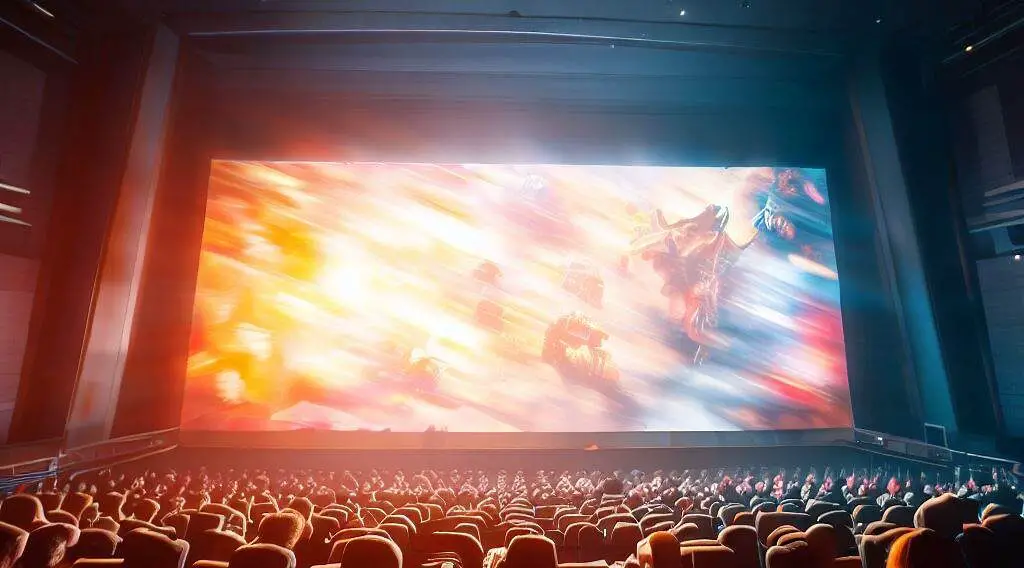Established in 1967, IMAX has become the premier experience for movie enthusiasts throughout the known world. The IMAX Theatre became popular due to its larger screen and superior audio and visual quality, but what exactly separates a normal theatre from an IMAX?
Well to give you a better idea, I’ll be comparing the difference in screen, projectors, speakers, ticket cost and much more.
Comparing IMAX and Standard Theaters
If I was someone working for IMAX back in the day that wanted to convince you of its superiority, I would probably start with the fact that the screen ratio is about six times bigger than a regular theater. If that didn’t grab you I would go into the fact that the screen is curved to offer you a more complete view of the movie while also spanning nearly the entire length of the wall. Finally, I would go into the superior film quality that is offered by a 70mm film format, while the standard theater has to use 35mm.
Nowadays they rely on 4k laser projectors for the majority of theatres though it is possible to find IMAX theaters with 70mm film projectors. You can also be the victim of a fake IMAX theater or “Digital IMAX” theater that uses 2k projectors, which offers far worse quality overall. We will go over that a bit later.
I’m gonna be using the word IMAX a lot in this article and would like to apologize ahead of time.
A lot of the things a person will experience in an IMAX film have been carefully combed over by IMAX themselves. The projectors used for movie screenings in an IMAX theatre and made exclusively by IMAX and most films that are played in IMAX have been shot separately with IMAX cameras. This benefits the viewer because nothing has to be stretched or tampered with to fit the unique dimensions of the larger IMAX screens.
These IMAX cameras offer a lot more of the frame than a regular camera can provide. So for better or for worse, the viewer can see much more of the image in an IMAX screening of March of The Penguins than if they saw it in a regular theater.
The size of IMAX screens varies wildly from location to location with the biggest being an unimaginably large 144 by 75 ft. On average, however, these screens are typically somewhere closer to 52 by 72 feet. Due to the need for expansion at lower costs IMAX screens have definitely gotten notably smaller in some locations while still maintaining an equal or higher ticket price.
To compare, the average standard screen is anywhere from 45 to 65 feet in width and typically standard somewhere around 30 feet. This too can vary wildly depending on which theater you go to, and with the rise of PLF (premium large format) theaters we are seeing bigger non-IMAX screens popping up around the world.
This is a direct response from competitors to match the overwhelming success of IMAX theater’s larger screen format. Competitors like ScreenX are even going so far as to place screens on the sides of the theater in an attempt to one-up the immersive nature of IMAX.
While we don’t know how many speakers are in each individual theater, it seems typical that there are 44 throughout most. We do know that typically they use a six-channel sound system along with sub-bass. This comfortably beats the average cinema in your area, though it should be noted that Dolby Cinema provides the best sound quality you will find in a theater.
The seats are where everything begins to feel more equal. The seats of an IMAX theater are fairly unremarkable and show no real difference from the most mundane and rudimentary theaters on the market. This is a definite downside to the upgraded experience when you consider the ticket price compared to a standard theater.
The cost of an IMAX movie ticket for an adult averages 19.69 USD, which is astoundingly higher than the average ticket price of 9.57 by theaters across the United States. While you certainly get more for your money with an IMAX film, at twice the cost you really have to wonder if it is worth it for every movie. What I would tend to recommend is reserving IMAX for films you really wish to see on a much grander scale or films that were made specifically for IMAX.
The Rise of “Liemax” Theaters
Remember how we talked about IMAX’s desire to aggressively expand and how they were looking to do this at a discount? Welp, this brought in the vastly inferior fake IMAX or Liemax theaters. Despite assurances from the company that you can still enjoy a film on a screen that is a little under a quarter of the size of an IMAX screen, the statistics behind this statement tell a different tale altogether.
Essentially, IMAX saw that their theatres brought in an incredible amount of money despite how few there were in comparison to other franchises. So in a regrettable move for IMAX fans everywhere, after The Dark Knight became a massive hit (which had a few scenes filmed for IMAX) a sinister idea was formed. They started contacting theater chains and convincing them to fit much smaller screens into the IMAX format.
These screens were twenty-two percent the size of an average IMAX screen. They also used 2k digital projectors instead of the 4k IMAX is known for. They also forgot to mention the films were being projected in 2k (if you add two 2k projectors together, that’s 4k…right?) and would advertise films as 4k. Compared to a real IMAX theater, the image resolution is only a ninth of its superior predecessor.
On top of just under half of the image being cut out of the frame, you also have to deal with a gray hue that covers most of the pixels. This has been described as looking at a movie through door netting. A gray movie that has close to half of the image cropped out because of the smaller size of the screen.
The final straw that is breaking this significantly smaller camel’s back is the reduced sound quality. So while it will sound better than the average theater we compared IMAX to earlier, it is a pale comparison to IMAX and especially Dolby Cinema.
Thankfully, even though all these drawbacks are present at least we get a discount on the price of the ticket, Right? Not even a bit. In fact, depending on where you go, the cost of a fake IMAX theater is actually a bit higher than the real thing, which only further infuriates reviewers.
If you have an IMAX close to your area that you have yet to attend, be sure to look at reviews to make sure it is the real experience. No one deserves to pay close to twenty dollars to watch a movie on a standard screen with shoddy image resolution.
The Impact of IMAX on Filmmaking
While we’ve already discussed how the IMAX experience is a game-changer for movie viewers, it’s equally important to consider how it impacts filmmakers. IMAX’s top-notch technology and superior screen size can significantly shape a filmmaker’s creative process.
For instance, when a film is shot with IMAX cameras, it allows for a level of detail and scope that conventional cameras can’t capture. Some renowned directors, such as Christopher Nolan and J.J. Abrams, have been known to use IMAX cameras for filming key sequences of their blockbuster films.
However, filming with IMAX cameras can be a double-edged sword. The extra details captured by these cameras necessitate more cautious set design, makeup, and costumes since any flaws or discrepancies can be easily spotted on an IMAX screen.
Also, the sheer size of IMAX cameras, although much smaller than their older counterparts, can still pose challenges during filming. They can be harder to handle, especially for intricate and action-packed sequences.
Yet, despite these challenges, filmmakers who choose IMAX find it worth their while. The ability to showcase their creative vision on such a grand and immersive scale is something truly unique to the IMAX experience.
Closing Up
IMAX still separates itself from the pack for the most part with its outstanding visual quality and breathtaking size. Unfortunately, it is becoming hard to determine what is still the standard “IMAX Experience” and what is a theater in a shopping mall with IMAX slapped on the front. But if you can find the real deal in your local community, it is still worth the cost of admission for certain blockbusters.
FAQs
Why does an IMAX screen look brighter than a regular screen?
This is due to the advanced technology used by IMAX. IMAX projectors have a custom, proprietary design and utilize laser technology for illumination, which can create brighter and more vibrant colors compared to standard cinema projectors.
Are all movies available in IMAX format?
No, not all movies are released in IMAX format. The decision to release a film in IMAX is often made by the film’s production studio. However, films shot using IMAX cameras or those digitally remastered into IMAX format will typically be released in IMAX theaters.
Is the IMAX experience the same in all IMAX theaters?
Ideally, yes, the IMAX experience should be the same across all IMAX theaters. However, with the advent of “Liemax” theaters, there have been instances of subpar experiences. It’s always advisable to read reviews of the particular IMAX theater you plan to visit.
Can I watch 3D movies in an IMAX theater?
Yes, you can. In fact, 3D movies are especially spectacular in IMAX due to the larger screen size and high-resolution image quality. The IMAX 3D technology also utilizes special polarized 3D glasses, which help create an incredibly immersive viewing experience.
Are IMAX theaters only for Hollywood movies?
While IMAX is popular for Hollywood blockbusters, it’s not exclusive to them. IMAX theaters often screen documentaries, particularly ones involving nature and space exploration. These films truly shine on the massive screens and provide an educational and thrilling experience.

